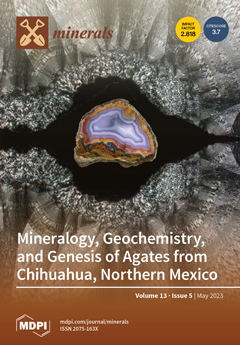The Alxa Block is an important component of the North China Craton, but its metamorphic basement has been poorly studied, which hampers the understanding of the Alxa Block and the North China Craton. In this study, we conducted geochronological and geochemical studies on
[...] Read more.
The Alxa Block is an important component of the North China Craton, but its metamorphic basement has been poorly studied, which hampers the understanding of the Alxa Block and the North China Craton. In this study, we conducted geochronological and geochemical studies on three TTG (tonalite–trondhjemite–granodiorite) gneisses and one granitic gneiss exposed in the Langshan area of the eastern Alxa Block to investigate their crustal evolution. The zircon U-Pb dating results revealed that the protoliths of the TTG and granitic gneisses were formed at 2836 ± 20 Ma, 2491 ± 18 Ma, 2540 ± 38 Ma, and 2763 ± 42 Ma, respectively, and were overprinted by middle–late Paleoproterozoic metamorphism (1962–1721 Ma). All gneiss samples had high Sr/Y ratios (41–274) and intermediate Mg
# values (44.97–55.78), with negative Nb, Ta, and Ti anomalies and moderately to strongly fractionated REE patterns ((La/Yb)
N = 10.6–107.1), slight Sr enrichment, and positive Eu anomalies, displaying features of typical high-SiO
2 adakites and Archean TTGs. The magmatic zircons from the 2.84 Ga and 2.49 Ga TTG rocks had low ε
Hf(t) values of −1.9–1.7, and −3.83–2.12 with two-stage model ages (T
DMC) of 3.24–3.11 Ga and 3.10–3.01 Ga, respectively, whereas those from the 2.54 Ga TTG rock exhibited ε
Hf(t) values ranging from −1.1 to 3.46 and T
DMC from 3.0 Ga to 2.83 Ga, suggesting that the crustal materials of the basement rocks in the eastern Alxa Block were initially extracted from the depleted mantle during the late Paleoarchean to Mesoarchean era and were reworked in the late Mesoarchean and late Neoarchean era. By contrast, the Alxa Block probably had a relative younger crustal evolutionary history (<3.24 Ga) than the main North China (<3.88 Ga), Tarim (<3.9 Ga), and Yangtze (<3.8 Ga) Cratons and likely had a unique crustal evolutionary history before the early Paleoproterozoic era.
Full article





